I was so fortunate to have been part of what was, really, the end of an era
I was born in 1951 at Rochford Hospital after my family had moved down from London so my father could take up a position at the military firing range on Foulness. My first connection with the Palace Theatre came when I was about ten years old on a school trip to see the panto Robinson Crusoe. I don’t remember much, but what I do remember was a large, very scary raven. The costume was amazing; it was covered with dark green and black feathers and had a hood with a ferocious beak which caused me to have nightmares for weeks after!
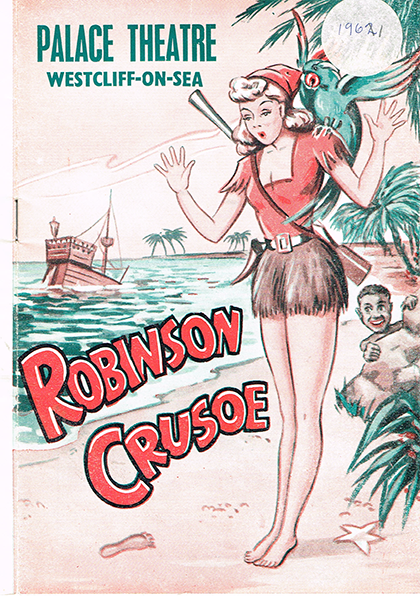
After Richmond Avenue Primary School, I went to Southend High School for Boys, where I was a bit of a ‘jack the lad’, and marked as the ‘likely lad who could do better’. I had no idea what I wanted to do with my life. My father, being a senior civil servant, wanted me to go into something solid like the Army, or banking or some such profession, but I knew that definitely wasn’t for me.
In my final year I was walking down the corridor when I saw a poster for an Inter Schools Drama production of King Lear. I’d never done any form of drama, but somehow I knew that I wanted to be in it. Miraculously, at that very moment, the English teacher, Mr. Godfrey, was coming in the opposite direction and I asked him if there were any parts still available. Unfortunately all the parts had gone, but he told me they did need someone to help out back stage. So I went along to the next rehearsal and ended up doing all the off-stage drums and thunder sound effects.
The play was being directed by a lady called Peggy Batchelor, a doyen of local amateur dramatics. She ran the Ridley Drama Studios, and most of the lead roles were being played by students who also attended her studio.
King Lear was played by Stewart Trotter, who was about to go to Cambridge to study English at Sidney Sussex. He then went on to become Peter Hall’s deputy at the National Theatre and later the artistic director at Exeter’s Northcott Theatre. Much later he and I co-authored the book Tales from the Palace Theatre, but that’s another story. Another of Peggy’s students was Godfrey Hamilton, who played Edmund. After a successful career as a journalist, he moved to Hawaii to become writer in residence for the Starving Artists Theatre Company. Then there was John Martin, who played the Fool, Poor Tom, who went on to run a theatre company touring India for the British Council, very much like Felicity Kendal’s father did back in the 1950s.
I left school before taking my ‘A’ levels and, having had a small taste of theatre, I enrolled on the drama course at the Southend College of Technology. The Head of Drama was Hilary Clulow, who had also taught at Ridley Studios. The Drama Department was based in the college’s Victoria Circus annex, which by coincidence had originally been the home for Southend High School for Boys, my old alma mater. Unfortunately the building was demolished a few years later: the new Odeon Cinema now sits on the site. When I was there it had really fallen into disrepair, but we loved it because we could make as much mess as we liked, an absolute necessity when building and painting sets for our productions. It was a two year course and after the first year I took some time out to get married. When I returned to finish the course a year later all the classes had moved to the College’s main building in Carnarvon Road – where we were definitely not allowed to make any mess whatsoever!
About the time I had enrolled at the College, Ray Cooney had taken on the job of running the Palace Theatre, and his second production was his farce One For the Pot, which he starred in and directed. In that production he had to appear in four separate places on stage in quick succession. He contacted Hilary Clulow at the college and I was selected to go along and double for him. I obviously had to wear a matching costume, in this case an evening suit, but unfortunately the costume department didn’t have one that fitted me. So I had to roll up the trousers and turn back the sleeves! Also, I was only 18 at the time, while Ray was obviously much older – and I also had a full head of black hair while Ray’s was light brown and thinning, so I’m not sure how many people we fooled, but it was great fun and my first ever appearance on the Palace stage in a professional production!
One of the stars who worked for Ray Cooney was Jill Browne. At the time she was best known as Nurse Carole Young in TV’s popular soap opera Emergency – Ward 10. She was terribly grand and one of my jobs was to pop to the Plough public house next door each evening at 7pm and buy her a glass of champagne. What style!
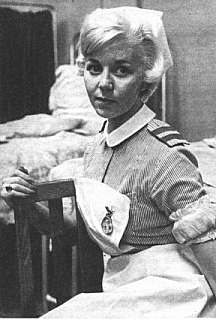
Jill Browne as Nurse Carole Young
While I was at college I had also started working as an assistant drama teacher, first at the Southend Junior Drama School and then at Ridley Studios. This experience working with young people was to prove invaluable because in 1977 I set up Theatre Union, a Young Peoples’ Theatre Company. I managed to get the use of the Southend Youth Theatre, later renamed Focus Theatre but now sadly demolished.
The first company was made up of some of the kids I had taught at Ridley. We met every Tuesday evening and I charged the grand sum of 50p for a three hour drama session, which just about covered the hire of the theatre.
Whilst I was running Theatre Union, I found out that Ray Burgoyne, a former boat builder who was now the master carpenter at the Palace Theatre, needed stagehands for the Sunday turnaround between shows. I went along to see him and started work the very next week erecting sets and sometimes even working as a flyman, flying in scenery during the productions. Ray was a top bloke and even allowed me to raid the skip for bits and pieces that could be used in Theatre Union productions.
We were really quite successful, getting to the final of the All-England Drama Festival in consecutive years. We had some really talented young actors and at the end of our first year eight of the sixteen group members were accepted into a number of London drama schools: Four getting into Guildhall, two into RADA (The Royal Academy of Dramatic Art), one into Webber Douglas and one into the Drama Centre.
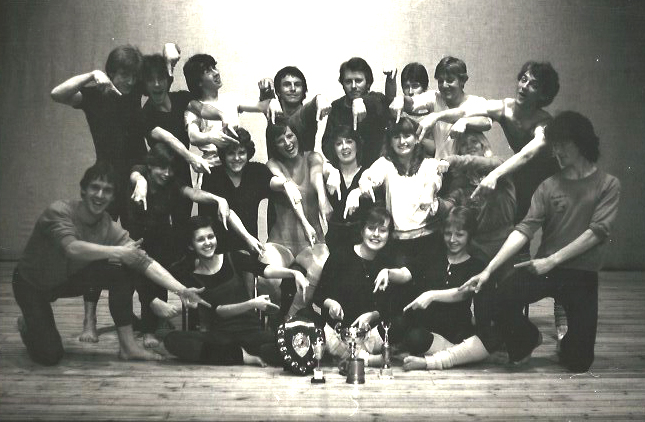
Theatre Union students, proudly displaying their well-deserved trophies.
[Photo: Charles Sharman-Cox]
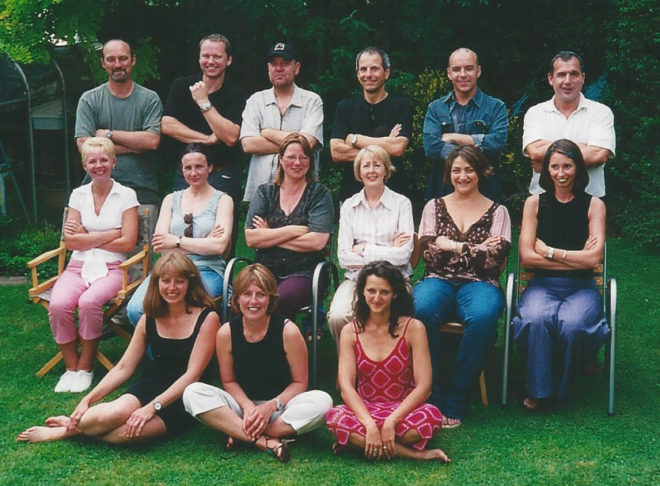
[Photo: Charles Sharman-Cox]
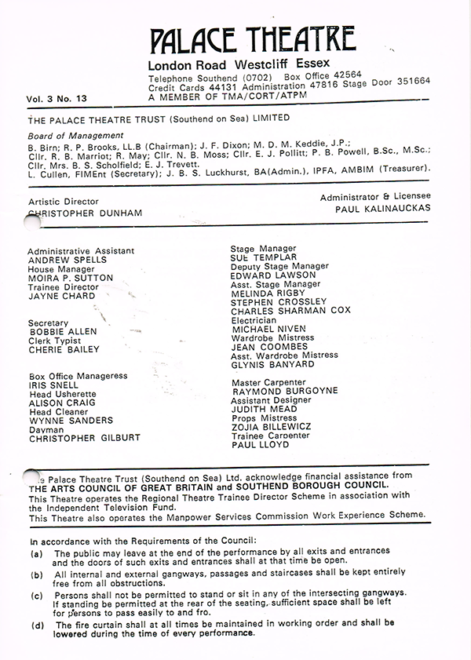
From the programme for A Bedfull of Foreigners: My first professional credit, as Assistant Stage Manager
My first ‘speaking part’ (well almost a speaking part!) came in September 1979 in Alan Ayckbourn’s Ten Times Table. During the piece Bernie, the company electrician, had to play a sound effect of a cuckoo at the same time as I operated the bird popping out of the cuckoo clock. Unfortunately he was never able to time this correctly and, as I was perfectly capable of simultaneously operating the bird and doing a passable impression of a cuckoo, I got the gig.
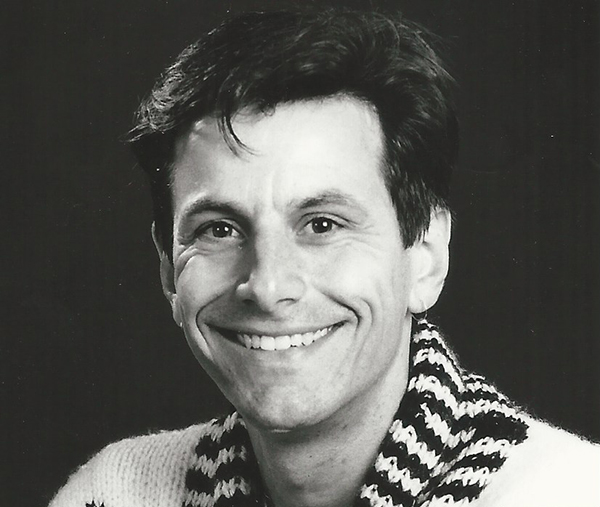
Me, starting out!
[Photo: Charles Sharman-Cox]
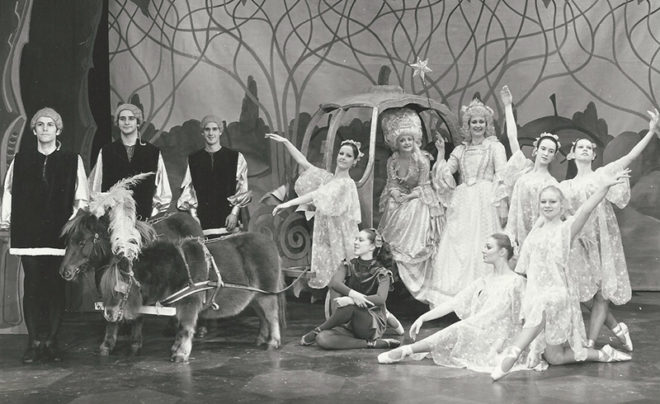
When I started out my original contract was for 40 weeks, at the end of which I would have gained full Equity membership. I must have been OK at the job because at the end of the contract I was offered another 40 week contract, only this time as the Deputy Stage Manager on a slightly higher salary. Of course I agreed to this on the spot, but with the understanding that I could still continue to take on any acting roles. In the theatre world this would was considered highly unusual, but thankfully Chris Dunham agreed and I continued to play parts throughout the contract – even after I was promoted to full Stage Manager.
Chris would put on an Agatha Christie which, like the panto, was a big money spinner, always playing to packed houses. In October 1979 we staged A Murder is Announced, in which I not only stage managed, but also played two parts: Rudi Schultz the murder victim and Sgt. Mellors a policeman who had come to investigate his death. Not only that but, in a blackout, I also had to fire the gun that killed him. A very schizophrenic production! The curtain would come down for the scene change with me lying dead on the floor. Immediately I would get up, reset the scene, take off my hat and coat, under which I was wearing a policeman’s uniform, hand them to someone else, be handed a policeman’s helmet by one of the other actors and be ready for the curtain to go up for the next scene, when I could inspect ‘my’ corpse!
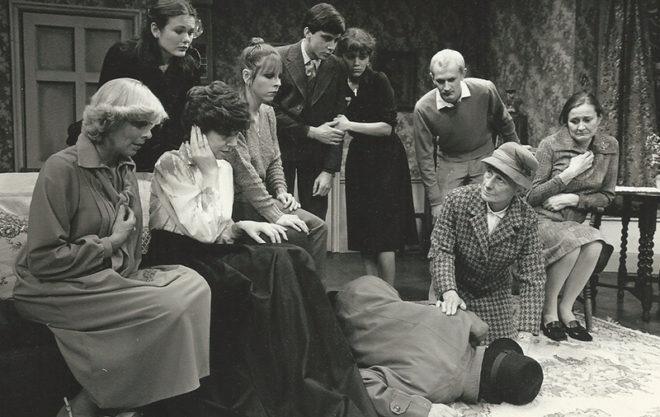
Rudi Schultz murdered!
At the end of the scene, it was my job, as the Police Sergeant, to ask the entire cast, assembled on stage, to leave the scene of the crime. Now there was only one way off, and that was through a door upstage centre. I remember during one performance when I grabbed the door knob it came off in my hand, which meant that everybody was now trapped on stage! Fortunately, there was still some dialogue going on between the Detective, played by David Crosse, and the rest of the cast. But I knew I had to get the door open, otherwise the show was over.
So, trying to be as inconspicuous as possible, I started edging my way down towards prompt corner to try and catch the attention of Stephen Crossley, the ASM on the book. Both the audience and the on-stage cast must have thought I had gone completely mad as I tried to get his attention. Eventually he twigged and rushed round to open the door for me, which he managed to do at the very moment I was to deliver one of my few lines: “Step this way please”! It was skin-of-your-teeth time, but the next day Chris Dunham called me into his office and thanked me for saving the day. Needless to say that door handle was firmly fixed on for the rest of the run!
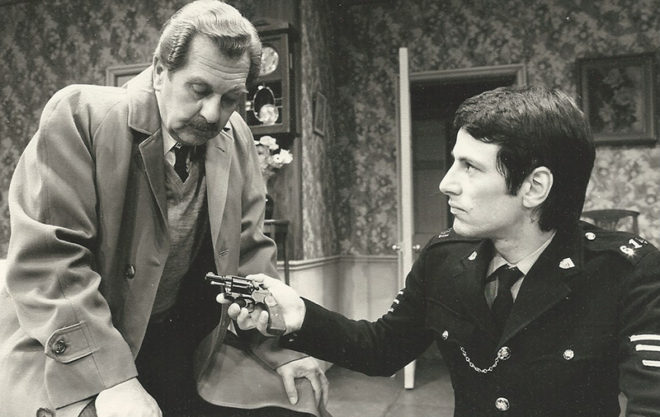
On the case: Inspector Craddock and Sgt Mellors try to figure out whodunit!
It was always my ambition to direct, and at the end of my second contract I left the Palace and formed English Company Theatre with Barry Philips, an actor who had come down to Westcliff to star in Joe Orton’s Entertaining Mr. Sloane in April 1979. Our first and only project was to take David Farrell’s two hander, A Slight Joke, to the 1980 Edinburgh Festival. Barry played the male lead opposite Southend actress and former Ridley Studios student, Rosalyn Elvin. As part of our pre-festival preparation we staged a one-off performance at the Palace, in August 1980, donating all the profits to the Dixon Studio Appeal. Sadly, David drowned whilst on holiday in the Dordogne, and 15 years later, in May 1995, as a tribute to a really good friend, I re-staged his play in the Dixon Studio.
Chris always attended the Edinburgh Festival, and having now seen my work as a director, he asked if I would like to be his assistant director back at the Palace. Of course I jumped at the opportunity and was lucky enough to direct on the main stage with Peter Nichol’s Born in the Gardens and Victoria Wood’s Talent, while in the newly built Dixon Studio I got to direct Jean Genet’s The Maids.
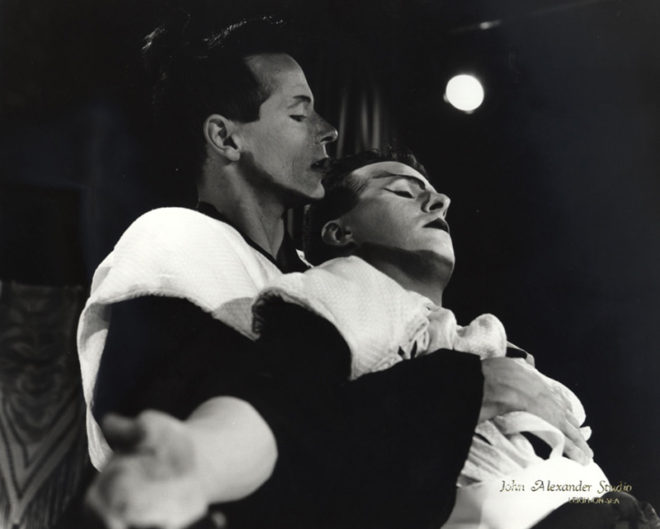
Peter Doran and Paul McLeary as the eponymous Maids
I also had the additional responsibility of running Palace-Go-Round, the Palace’s ‘Theatre to Schools’ company that visited local schools. I really loved this: writing, performing and directing for the company. I wrote six plays for it, including Terrible Ted and the Carousel, A Dip in the Thames, Inspector Quaver’s Musical Case and A Big Day for Mr. Punch. The plays would go out on three separate tours, and one memorable Mr. Punch of mine was none other than Ross Kemp, who of course went on to star in EastEnders.
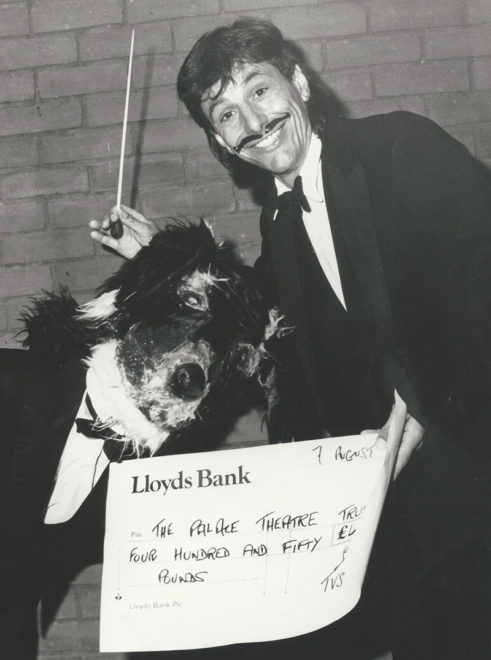
Inspector Quaver’s Musical Case: Me as Professor Pomposo and Tim Raynham as his sidekick Presto the Dog
[Photo: Charles Sharman-Cox]
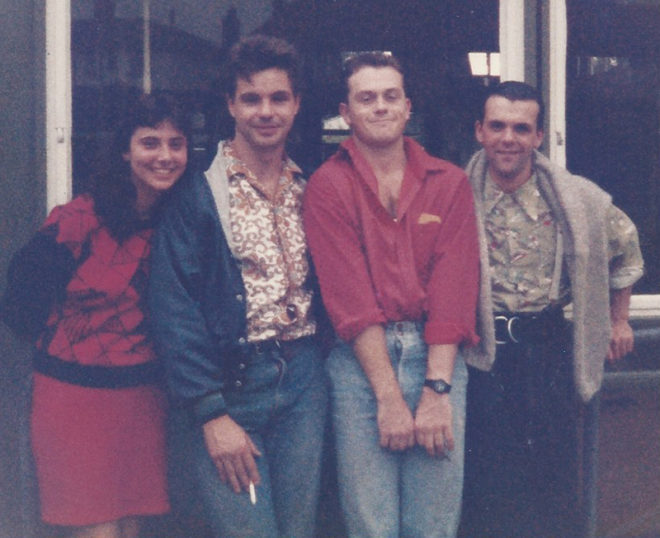
Third from left: A young Ross Kemp, on tour with Palace-Go-Round in his first professional engagement
[Photo: Charles Sharman-Cox]
In December 1980, my wife Jennie gave birth to our daughter Hannah during the run of Puss in Boots and I’ll never forget Chris announcing to the audience at the end of the show that his brother Prune (or was it Custard) had just become a dad and presenting me with a bottle of champagne. I think that even made the front page of the Evening Echo.
In my final year Chris decided to move away from a traditional pantomime and instead he staged two Christmas shows: Tim Rice and Andrew Lloyd Webber’s Jesus Christ Superstar in the evenings and Christopher Lillicrap’s Christmas Cat and the Pudding Pirates in the afternoons. However both of us still liked to step on stage, so Chris directed Superstar as well as playing Herod and I directed Christmas Cat as well as playing the baddie, Captain Rat.
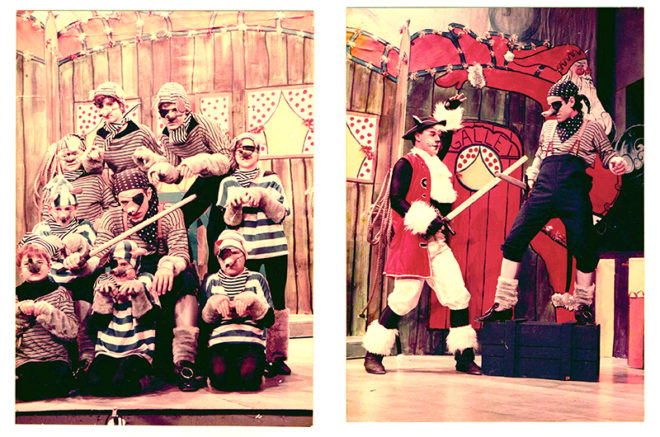
Me, as Captain Rat, with my fearsome Ratlings, and in a desperate duel with Tim Raynham as Christmas Cat, in Christmas Cat and the Pudding Pirates (December 1983)
In 1984 it was decided that the theatre needed a makeover, which included replacing all the seats in the main auditorium. Chris had always wanted to do a promenade production of Lark Rise to Candleford (his wife June Watson had been in the original National Theatre production). My role was to organise a four week series of additional attractions in the foyer before the show started. We called this A Mid-Summer Lark and I found a whole raft of acts, from Morris dancers to mummers, from folk bands to jugglers and clowns. Every Friday night after the play we also held a massive ceilidh with bands such as Flowers and Frolics, Blowzabella, The Old Swan Band and The Oyster Band with Mick & Sarah Graves. It was certainly one of the highlights of my time at the Palace.
My stint as the associate director finally came to an end when Chris acquired the services of director Di Trevis, who had won an Arts Council bursary to work in regional repertory. She was a very strong-willed lady, and in May 1984 she persuaded Chris to put on Edward Bond’s Saved. It was an extremely controversial play with some very harrowing scenes, and, despite having a young Gary Oldman in the lead role, resulted in almost empty houses.
Fortunately for me I had been approached by a video production company which was looking for a freelance writer/director to work on a series of drama documentaries, so I decided to make the move to television, which has been my life pretty much ever since. However, the good thing about that initial nine month contract was that it allowed me to continue my freelance theatre work. Together with actor/composer Michael Heath I formed the Umbrella Theatre Company, and our first project was my own stage adaptation of Bill Bryson’s The Lost Continent, followed by Steven Berkoff’s Greek and then the revival of David Farrell’s A Slight Joke.
Funding for the arts was getting tighter and tighter, and the Arts Council, principal funders of the Palace, had told Albert Reddihough, the Chairman of the Board of the Palace Theatre Trust, that they were not entirely happy with the way things were working out. Chris had been there since June 1975 and there was no-one on the Board who really knew about professional theatre. They strongly suggested that if the theatre wanted to continue being funded then the Board should appoint someone who could bring a theatrical perspective to its work. I was still living locally, so out of the blue I got the call to join the Board.
Unfortunately things were going from bad to worse, financially speaking, and, after a particularly unsuccessful production of Rogers and Hammerstein’s Carousel Chris was unable to balance the books at year end.
The only solution on the table for the Board was for Chris to make use of a contingency fund set aside by the Council to meet any outstanding financial obligations (such as patrons, who had pre-booked tickets, and other creditors) in the event of a financial collapse. I think this sum was in the region of £80,000. I was terribly conflicted because I really didn’t think this was the right course of action, but by voting not to use the fund I was, in effect, voting for closure. In the end I abstained, but on the casting vote of the Chairman the motion to use the contingency was approved and, consequently, I felt my only course of action was to resign.
And, whilst this measure did allow Chris to balance the budget and keep the theatre afloat, it proved to be only be a temporary fix and the theatre finally closed its doors to the public in March 1999. The Palace remained dark until the following Christmas when it was taken over by London production company Green and Lenagan, which immediately appointed Roy Marsden as artistic director. Sadly this incarnation was also doomed to failure as the theatre went dark again in 2002.
In April 2003, now with no in-house productions at all, the Council re-opened the Palace under joint management with the Cliffs Pavilion. However, fearing for its long-term future, in February 2005, local actor Sebastian Abineri organised a public meeting at the Palace, and the Palace Theatre Guild was set up to fight any proposed closure. This is where my love affair with the Palace Theatre was rekindled.
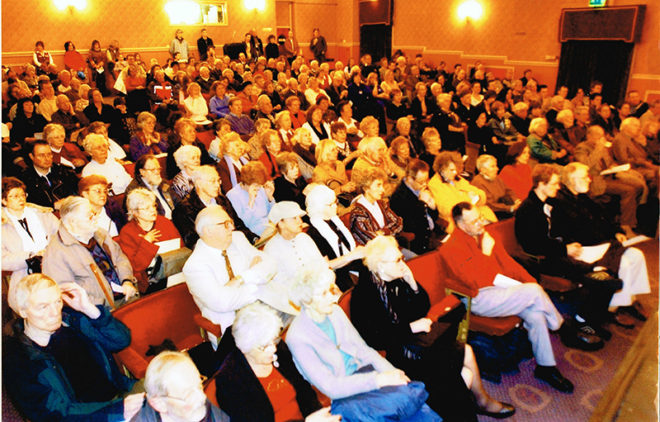
Entertainer and theatre enthusiast Roy Hudd among the packed house at the public meeting
After first serving as a Guild member and helping to organise a number of fund-raising events, such as a National Radio Drama Playwriting Competition and staging a concert version of A Christmas Carol, a piece I had written with Michael Heath some years previously, which raised over £5,000, I was appointed chairman of the Guild in 2006.
Subsequently, the Palace and the Cliffs were put out to tender, and HQ Theatres was appointed to run both venues. Happily, the Palace re-opened in November 2007 with a Gala Variety Night in aid of the Palace Fund, presented by the Guild. HQ Theatres’ tenure started the next month, with The Wizard of Oz as the Christmas attraction.
With the theatre’s future secured, there was really no need for the Guild to continue and so, with a healthy bank balance, we decided to use that money to commission a book on the Palace Theatre which we titled Tales from the Palace Theatre 1912 -2012. We even managed to get Helen Mirren, a local girl who credits a school visit to the Palace as sparking her interest in performing, to write the foreword.
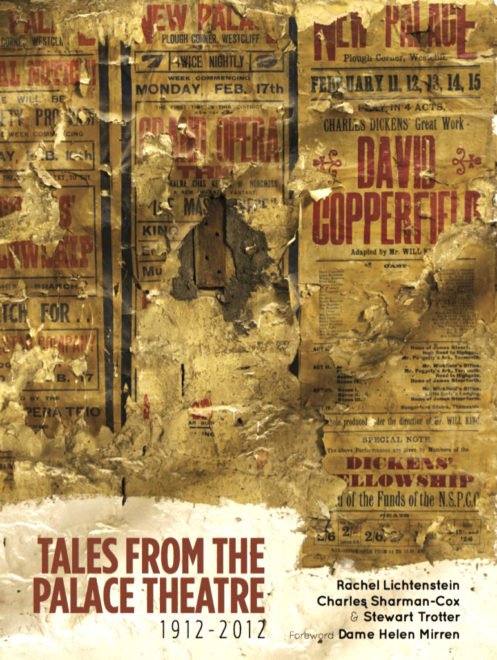
Written and edited by myself, Stewart Trotter and Rachel Lichtenstein, a limited edition of 500 were printed in time for the Palace Centenary, with all profits going to The Palace Theatre Club to help maintain the fabric of the building.
So that’s my Palace story. I had some great times and I have some fantastic memories. I still can’t believe that I’ve been involved with this theatre on and off for nigh on 50 years – from being a student actor, stage hand, ASM, DSM, SM, Associate Director and Board member. Rep was fantastic, even though that period did seem like the end of an era.
But I am delighted that the dear old Palace is still there and still going strong. Long may it continue!

[Photo: Charles Sharman-Cox]
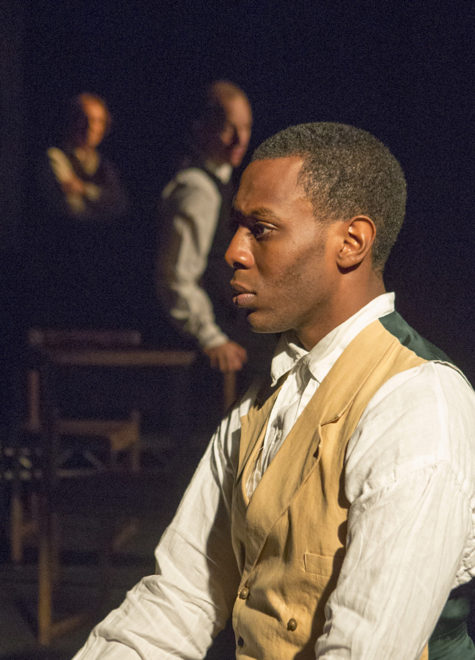
Craig Talbot as Dorian Gray, with David Streames as Oscar Wilde and me as Lord Henry Wotton
[Photo: Charles Sharman-Cox]


Comments about this page
I played Ernie, the carnival barker, in “Mr Punch’s Big Day Out” with Ross Kemp, in 1986. I sooooo wish I had a photo of him in it! He looked hilarious.
Add a comment about this page